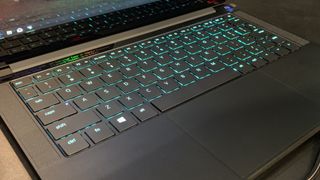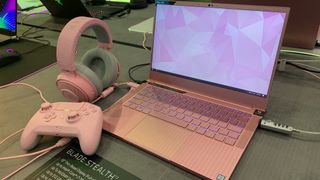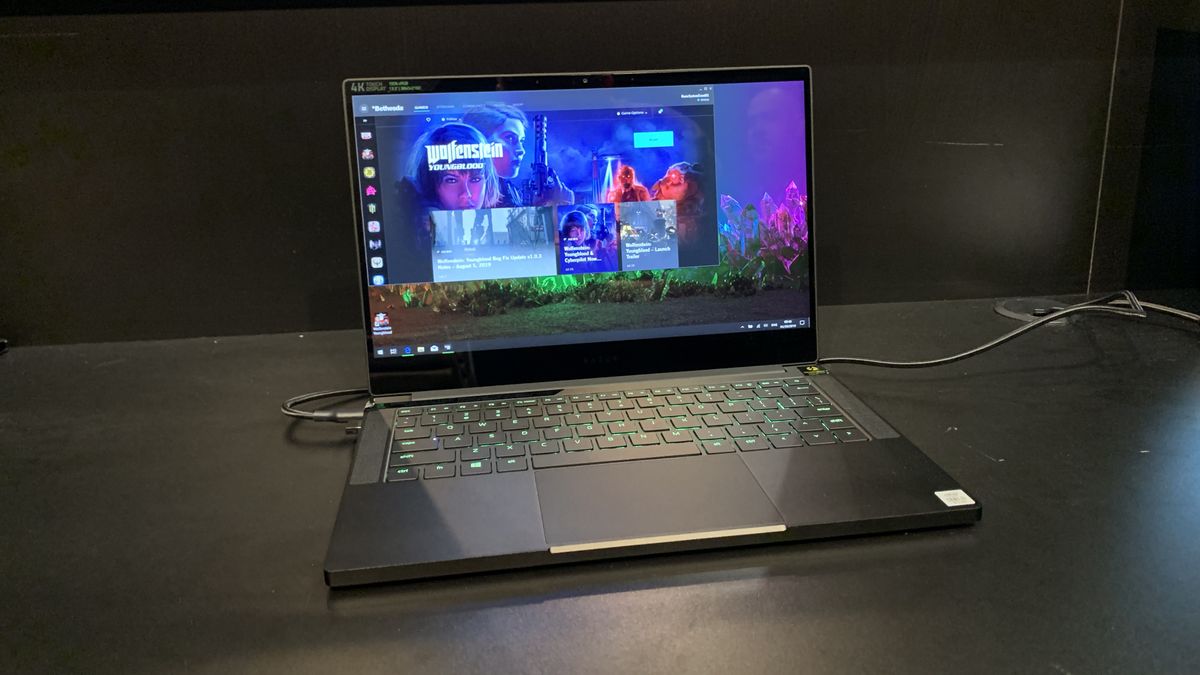Early Verdict
The Razer Blade Stealth is an incredibly thin and light Ultrabook already, but the added graphics horsepower that the Nvidia GeForce GTX 1650 brings may end up making this the perfect gaming laptop for anyone that likes to travel light.
Pros
- +
Thin and light
- +
Finally, decent dedicated graphics
- +
Beautiful display
Cons
- -
A little expensive for the parts on offer
- -
Mercury White color option limited to non-GTX model
Why you can trust TechRadar
The Razer Blade Stealth has always been a peculiar device. Essentially an Ultrabook marketed as a gaming laptop, it's always lacked the dedicated graphics horsepower to really live up to its promise. But, that may have changed with the Late 2019 model at IFA 2019.
This time around, Razer has managed to create a Blade Stealth with an Nvidia GeForce GTX 1650 graphics processor (GPU), alongside a 10th-generation Intel Ice Lake processor – finally crafting a ultra-portable laptop that can actually get some gaming done – even if it isn't the most powerful laptop on the street.

Pricing and availability
If you're in the US and are looking to get your hands on the new Razer Blade Stealth, you're in luck. You'll be able to order it starting late September 2019, starting at $1,499 (about £1,230, AU$2,220). For that price, you'll get an Intel Core i7-1065G7, 16GB of RAM and a 256GB SSD.
However a top end model, with the same Ice Lake processor – albeit at a lower thermal design power (TDP) – but with an Nvidia GeForce GTX 1650 GPU, it will likely be much more expensive. We don't have the exact pricing for this model yet, but with this kind of horsepower in this little chassis, don't expect it to come cheap.
If you're looking at the Razer Blade (2019), this will set you back US$1,599 (£1,499) for its base configuration that boasts an Nvidia GTX 1060, 128GB SSD, 1TB of storage and a 60Hz display.





Design
Over the last few years, Razer has earned quite a few comparisons to Apple with its laptop design – in a good way. The new Razer Blade Stealth is just as sleek as ever, though if you're going to opt for a model with the Nvidia GeForce GTX 1650, you're going to have to live with a slightly heavier chassis – coming in at 3.26 lbs for the 4K model, compared to the 2.99 lbs of the Mercury White model with integrated graphics.
The Razer Blade Stealth (Late 2019) is as thin as ever. Measuring just 0.6 inches thick, it's a laptop you'll have no trouble carrying around with you wherever you go. Keep in mind that this is a 13-inch laptop, too, so its overall footprint is extremely reasonable.
Speaking of the display, the model we saw at IFA 2019 came with a 4K touch panel, and it was lovely. Colors pop and the bezels were thin enough to blend into the background.
This year, the Razer Blade Stealth comes in two different color options, Mercury White and the traditional Black. Now, unlike a lot of other laptops, which will let you choose the exterior color option regardless of the internals, you'll have to settle with integrated graphics with the Mercury White model, where the Black Razer Blade Stealth comes with the Nvidia GeForce graphics. However, the processor in the Mercury White model is more powerful, making it a better option for folks that need to get some work done in an office.
Still, we feel like this will be a hard pill to swallow for anyone that wants that beautiful Mercury White color option, but also wants powerful graphics. We're just speaking for ourselves here, but we'd like to be able to carry around a gaming laptop that looks as sleek as that Mercury White model.
Regardless of the color option you go for, the Razer Blade Stealth is as attractive as ever, with one of the best keyboards on an Ultrabook we've ever used. Then, there's that trackpad – short of going for a MacBook, you won't find a better trackpad on another laptop.

Performance
In the past, if you wanted to get some gaming done on the Razer Blade Stealth, you would have needed to opt for an external graphics solution, via Thunderbolt 3. Even with the Nvidia MX150 graphics in the most recent model, most AAA games are nigh-unplayable, even at 1080p.
However, with the inclusion of the GTX 1650 that should change dramatically. We got a chance to run Wolfenstein: Youngblood on the Razer Blade Stealth, and it was actually a smooth experience. Now, we had to keep the visual settings turned down to medium, but we were still getting a smooth 1080p, 60 fps experience – in a 13-inch laptop. At this size, it's incredibly difficult to fit in powerful graphics without starting a fire, so we appreciate anything we can get.
Elsewhere, you'll find an Intel Core i7-1065G7 – at 25W in the Mercury White model and 15W in the Black GTX Model. This disparity in wattage will mean that professionals who need a powerful CPU first, and don't care about graphics as a priority, will want to go with the Mercury White model.
We haven't had a chance to run our full suite of benchmarks, but realistically, either option should be just fine for most users. We do have to admit that we're intrigued by a 25W chip in a 13-inch laptop, and we can't wait to see how thermals play out in our testing.
Rounding everything up with 16GB of RAM and up to a 512GB SSD, the Razer Blade Stealth (Late 2019) should be more than powerful enough for most users. You might even be able to get some video editing done on an ultraportable 13-inch laptop – provided the thermals hold up.

Early verdict
From what we can tell, the new Razer Blade Stealth is closer than ever to living out the device's original promise: an ultra-light and ultra-portable gaming laptop. For the first time, you can get decent performance in modern PC games, without having to rely on costly external graphics solutions.
The real test of this device is going to end up depending on how well the thermals hold up in such a small chassis. If Razer found a way to keep temperatures down, we could end up with one of the best gaming laptops for anyone that needs to game on the go, while traveling light.
Bill Thomas (Twitter) is TechRadar's computing editor. They are fat, queer and extremely online. Computers are the devil, but they just happen to be a satanist. If you need to know anything about computing components, PC gaming or the best laptop on the market, don't be afraid to drop them a line on Twitter or through email.
What is a hands on review?
Hands on reviews' are a journalist's first impressions of a piece of kit based on spending some time with it. It may be just a few moments, or a few hours. The important thing is we have been able to play with it ourselves and can give you some sense of what it's like to use, even if it's only an embryonic view. For more information, see TechRadar's Reviews Guarantee.
